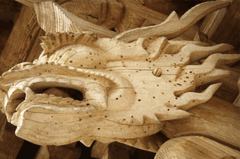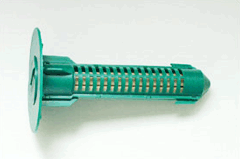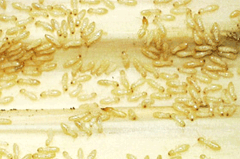Research Activities
Survey Monitoring
We use biological science techniques to perform scientific research related to biological and chemical influences on organic artifacts such as paper and fabrics, as well as taking precautions against the biological damage of wood, stone and metal artifacts. We also perform preservation environment monitoring in order to generate rational protection plans related to the damage environment of stone artifacts that are exposed to the elements.
Research for Prevention of Biological Damage

Damage by insects and microorganisms on organic cultural properties such as paper, wood and fabrics is studied, along with pest control methods to minimize biological damage by integrating traditional and modern science and technology. Most notably, the NRICH has developed an insecticide and fungicide from natural medicinal materials (Patent Registration No.0421539). Current projects include investigation of physical and chemical deterioration of traditional mulberry paper (Hanji) and scientific research to define the causes of damage and develop permanent preservation measures.
An onsite survey of the organic damage of wood cultural assets
Onsite surveys of the preservation condition and organic damage of wood cultural properties by each harmful cause such as termites were conducted to take proper measures for the prevention of organic damage to wood cultural assets. According to the results of the surveys, wood structures were found to be damaged by harmful insects such as cigarette beetles (Lasioderma serricorne), powder-post beetles, white ants, and bees (Carpenter bees, sphecidae), as well as by other elements such as rot fungi and humidity, causing the rotting, cracking, and breaking damage of wood.
Wood damage by bees
 The condition of base block damaged by white ants
The condition of base block damaged by white ants
 The surface of the door threshold damaged by white ants
The surface of the door threshold damaged by white ants
 The perforated damage of columns caused by bees
The perforated damage of columns caused by bees
 The perforated damage of roof edges caused by bees
The perforated damage of roof edges caused by bees
Wood damage by death-watch beetles (Stegobium paniceum)
 Condition Ⅰ of wall lines damaged by death-watch beetles (Stegobium paniceum)
Condition Ⅰ of wall lines damaged by death-watch beetles (Stegobium paniceum)
.gif) Condition Ⅱ of wall lines damaged by death-watch beetles (Stegobium paniceum)
Condition Ⅱ of wall lines damaged by death-watch beetles (Stegobium paniceum)
Wood damage by powder-post beetles
 The condition of columns damaged by powder-post beetles
The condition of columns damaged by powder-post beetles
 The damage of columns caused by powder-post beetles
The damage of columns caused by powder-post beetles
Wood damage by rot fungi
 The damaged condition of wood by wood-rotting fungi
The damaged condition of wood by wood-rotting fungi
 The condition of columns damaged by rot fungi
The condition of columns damaged by rot fungi
Termite Control Methods for Wooden Cultural Heritage
Monitoring
To prevent termite damage on wooden buildings and structures, the conservation team of the National Research Institute of Cultural Heritage places a piece of wood on or in target buildings and structures and monitors it for any signs of infestation. This method of monitoring is effective indetermining the distribution of termite colonies in the surrounding areas of a historic wooden structure. When a sign of invasion is detected in an area, all wooden structures and buildings in the vicinity are treated with insecticides.
monitoring investigation
- Location : Odaegung Palace (2000 ~ 2003)
 The installed condition of wood specimen for a monitoring purpose (July 2002)
The installed condition of wood specimen for a monitoring purpose (July 2002)
 The condition of wood specimens under monitoring, which are being damaged by white ants (July 2002)
The condition of wood specimens under monitoring, which are being damaged by white ants (July 2002)
 The condition of wood specimens under monitoring, which are damaged by white ants (June 2003)
The condition of wood specimens under monitoring, which are damaged by white ants (June 2003)
Fumigation Treatment
Fumigation is a method of killing insects and fungi after sealing the wooden cultural heritage in question. It is considered as one of the best ways to protect cultural heritage from insects and fungi because it is effective and does minimal chemical damage to wood. However, the effect of fumigation does not last long, making follow-up treatment necessary. In Korea, the fumigant used is a gas composed of methyl bromide and ethylene oxide mixed in the proportions of 86:14.
Examples of Fumigation (Daeseongjeon of Jangsuhyanggyo)
 Daeseongjeon of Jangsuhyanggyo
Daeseongjeon of Jangsuhyanggyo
 Installation of scaffolds and protective strips for roof tiles
Installation of scaffolds and protective strips for roof tiles
 Completion of fumigation sheaths
Completion of fumigation sheaths
 Hoses installed to measure gas concentration
Hoses installed to measure gas concentration
 Insects and escherichia coli installed to measure effectiveness
Insects and escherichia coli installed to measure effectiveness
 Fumigant applied with a vaporizer
Fumigant applied with a vaporizer
Soil Treatment
Spraying insecticides on the foundation of a wooden structure or around it can effectively prevent invasion by termites by creating a shielded zone around the structure. Soil treatment for termite control, however, must be preceded by a study of its potential consequences on water quality in the surrounding area and the health of local residents and the flora and fauna.
Insecticides used for termite control includes Bifenthrin and Kilbe special-60.
Example of Soil termiticide Treatment
National Treasure Jongmyo Jeongjeon (Royal Ancestral Shrine)
- Conducted in August-September 2001
 Drilling holes on the building's ground floor
Drilling holes on the building's ground floor
 A pressure injection of insecticide into perforated holes
A pressure injection of insecticide into perforated holes
 Injection of insecticide into the rear of Jeongjeon(Space between a column and a wall)
Injection of insecticide into the rear of Jeongjeon(Space between a column and a wall)
 This condition of the frontal side of Jeongjeon (Space between a column and a wall) after the injection of insecticide
This condition of the frontal side of Jeongjeon (Space between a column and a wall) after the injection of insecticide
Termite Colony Elimination System
This method of luring termites out of their nests to eliminate the entire colony has little to no impact on the environment, and is hence more environment friendly than methods involving chemicals.
Coupled with regular monitoring, it can effectively prevent the invasion of wooden structures by termites nesting in the surrounding areas. However, luring termites out of their nests, using an attractant, is a rather slow process, taking anything between three and six months.
Efficacy test of Termite Colony Elimination System
- Location: Jongmyo (Royal Ancestral Shrine)
 Global station
Global station
 Single Station
Single Station
A system of disintegrating an army of white ants
 The installed condition of the group disintegration system
The installed condition of the group disintegration system
 Regular monitoring conducted
Regular monitoring conducted
 The appearance of white ants damaging wood specimens
The appearance of white ants damaging wood specimens
 Injection of baits to disintegrate an army of ants
Injection of baits to disintegrate an army of ants
 The appearance of white ants eating baits which were used to disintegrate an army of ants
The appearance of white ants eating baits which were used to disintegrate an army of ants
 The effect of bait substance in the removal of white ants
The effect of bait substance in the removal of white ants
Research on the preservation environment of stone cultural assets
Research for Outdoor cultural assets can be affected by various environmental elements such as topography, vegetation, and hydrological environment as well as regional climate. In particular, stone cultural assets may look sturdy, but they are kept outdoor, so they are likely damaged by a natural weathering process and humans, and a proper preservation measures should be taken urgently. Accordingly, a long-term monitoring of the damage and preservation environment of important cultural assets such as Seokguram Grotto, Gyeongju, Rock-carved Standing Buddha Triad, Seosan and Rock-carved Standing Buddha Triad in Dongmun-ri, Taean should be conducted. The relationship between the damage and the preservation environment of important cultural assets should be studied scientifically in order to derive proper environment-control measures.
 Rock-carved Standing Buddha Triad, Seosan
Rock-carved Standing Buddha Triad, Seosan
 Rock-carved Standing Buddha Triad in Dongmun-ri, Taean
Rock-carved Standing Buddha Triad in Dongmun-ri, Taean
 Stone Buddha Statutes in Unjusa Temple
Stone Buddha Statutes in Unjusa Temple
 The measurement of micro meteorological phenomena of UnjusaTemple
The measurement of micro meteorological phenomena of UnjusaTemple
Research on the preservation environment of Seokguram Grotto, Gyeongju
(National Treasure)

Seokguram Grotto, Gyeongju (Originally named Seokbulsa Temple) was built by Kim Dae-seong commissioned by King Gyeongdeok (751AD), and it was not until 774AD that the temple was completed during the reign of King Hyegong. The man-made granite grotto located halfway up the Tohamsan Mountain has a statue of Sakyamuni Buddha surrounded by smaller status of bodhisattvas, disciples, generals, and Heavenly Kings. Originally a total of 40 sculptures were carved, but only 38 remain today. Seokguram Grotto, Gyeongju is regarded as the best of Silla's Buddhist masterpieces, particularly because it's a seamless combination of architecture, geometry, religion, and art. Seokguram Grotto, Gyeongju is listed as National Treasure as well as a UNESCO World Cutural Heritage Site.
Repair and maintenance of Seokguram Grotto, Gyeongju
The damage of Seokguram Grotto, Gyeongju was done in around 1905 by the Japanese army in the process of cracking down on Korean voluntary civilian army who rebelled against Japanese invasion and in the process of the Japanese pillage of Korean cultural assets. The frontal part of the grotto was collapsed and part of the ceiling of the grotto was damaged by the Japanese army at the time.
Japanese attempted to repair the damage several times to hide their atrocity inflicted on the cultural assets, but they ended up causing irreparable damage to Seokguram Grotto, Gyeongju. However, Japanese attribute the cause to our insufficient investigation.
1. Repair during the Japanese Colonial Period (1910-1945)
The Japanese carried out repair works three times during this period, removing the moss from stone surfaces with steam in 1933 and 1945.
- First Repair Project (1913-1915)
- Before repair works, one-third of Seokguram's ceiling had fallen off and the remaining part of the ceiling was in danger of collapsing. Also, a large portion of the cave temple was buried under a landslide. But as repairs were focused too heavily on replacing the destroyed stone blocks and reinforcing the walls, the surfaces of the grotto were turned into one giant piece of concrete.
- Second Repair Project (1917)
- After the first round of repairs, Seokguram'sceiling and walls began to leak. Mortar and clay were applied on the leaking areas.
- Third Repair Project (1920-1923)
- Even after the second round of repairs, the ceiling and walls continued to leak. So a waterproof layer and a drainage system were installed.
- Repairs in the Late Colonial Period
- After the third repair project and toward the end of the Japanese occupation, the leakage continued and the surfaces were covered with green moss. There is a record stating that steam was used to remove the moss in 1933 and 1945
2. Maintenance after Liberation
After Korea's liberation from Japan in 1945, Seokguram Grotto, Gyeongju was left untouched due to the Korean War (1950-53) and ensuing social chaos. But after a cleaning project in 1957, more people became interested in the grotto and worried about its state of preservation. A conservation committee was formed and extensive research took place from 1958 to 1961. From 1961 to 1964, the special committee built wooden structures to support the grotto. A fourth round of repairs was carried out to build another waterproof layer. But condensation continued to be a problem, so an exit door and air conditioning system were installed as a prevention measure. Partial repair works were carried out from 1976 to 1977 to install protective glass walls, improve the lighting, and expand the front base.
3. Conservation Environment of Seokguram Grotto, Gyeongju
Although the leaks were repaired after a secondary dome and protective walls were installed during the repair works from 1961 to 1964, an air conditioning system had to be installed in 1966 to prevent condensation through the control of temperature and humidity levels inside Seokguram. The air conditioning system is replaced every 10 years, and the current system was installed in 2005.
- Investigation of Conservation Environment
- At Seokguram Grotto, Gyeongju, temperature and humidity sensors (3 sensors inside the grotto; 2 sensors in dual dome) and one carbon dioxide sensor (One inside the grotto) were installed since 2007 for the real-time monitoring of conservation environment through a remote monitoring system.
 Monitoring of the environment of Seokguram Grotto, Gyeongju
Monitoring of the environment of Seokguram Grotto, Gyeongju
 Remote monitoring system
Remote monitoring system


